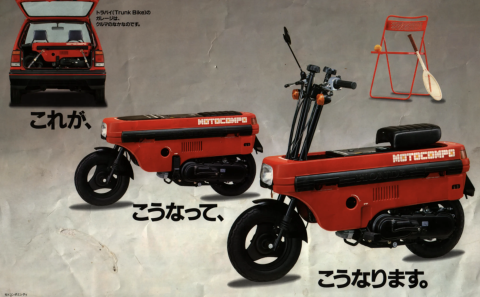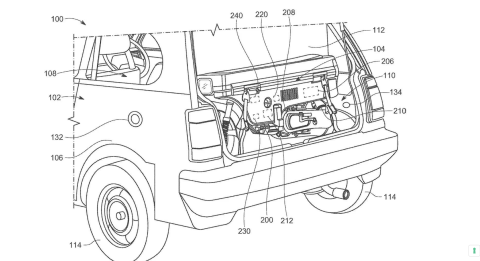In a move that could redefine how we think about electric vehicles (EVs), Honda has filed an intriguing patent for a range extender—but not the kind we’re used to. Instead of a typical gasoline-powered generator or battery pack, Honda’s vision involves using a miniature motorcycle as a versatile tool that could do more than just extend the range of an EV.
The patent reveals a clever system in which this small, foldable two-wheeler would be stored in the trunk of an electric vehicle, offering not only a novel way to increase driving range but also a secondary, alternative mode of transport for short trips. It’s a bold and unorthodox idea that showcases Honda’s forward-thinking approach to mobility solutions in an increasingly electric world.

A New Take on EV Range Anxiety
Range anxiety has long been a sticking point for many drivers considering the switch to electric vehicles. While modern EVs boast better batteries and longer ranges than ever before, the idea of running out of juice remains a concern, especially for long road trips or in regions with limited charging infrastructure. That’s where traditional range extenders—small gasoline engines used to power the vehicle when the battery is depleted—come into play.
Honda’s take on the range extender flips this concept on its head. Instead of a typical gas engine that merely recharges the battery, the patent outlines a portable mini motorcycle that not only offers extra range but also becomes a transport solution in its own right. If the car runs low on battery or the driver simply wants a more efficient way to navigate urban environments, they can deploy the compact bike and ride away, effectively turning the vehicle into a dual-purpose mobility solution.
The Design: A Nod to Honda’s History
According to the patent filings, the motorcycle resembles the Honda Motocompo, a foldable scooter produced in the 1980s. The Motocompo was designed to fit in the back of small cars, like the Honda City, offering drivers a last-mile transport option. The idea seems to be revived in this new patent, with a sleeker, more modern interpretation of the concept.
The drawings suggest a highly compact, foldable design, with handlebars and other components that can retract into the bike’s body, making it easier to stow in the car’s trunk. The motorbike would be small enough to be packed alongside luggage, and it could be deployed when the situation calls for it—whether to tackle congested city streets, make a quick grocery run, or even navigate areas where cars aren’t allowed.
A Portable Powerhouse: More Than Just a Range Extender
What sets Honda’s concept apart from traditional range extenders is its multi-functionality. Most gasoline-powered generators in EVs serve a singular purpose: keeping the battery charged so the car can keep going. Honda’s mini motorcycle, on the other hand, would add versatility to the equation. While its main function could still be as a generator that helps power the EV, its secondary role as a fully functional motorcycle makes it a game-changer.
Imagine driving into a congested city with limited parking. Instead of circling the streets in search of a spot or charging station, you could simply park your EV on the outskirts and use the motorcycle for the rest of the journey. It could also be an asset for road trips, where drivers could park their car and take a scenic ride on two wheels.
This dual functionality gives Honda’s concept an edge over other range-extender solutions, turning the EV into a modular mobility platform capable of adapting to a wide range of situations. And while the concept is still in patent form, its potential could signal a significant leap forward for electric vehicle design.

Challenges and Potential
Of course, as with any patent, there’s no guarantee that Honda will ever bring this idea to production. The design could face challenges in practicality and market adoption. Would drivers see the need for a portable motorcycle in their EV? How much additional weight and space would it take up? And how would the motorcycle’s gasoline engine impact the overall eco-friendliness of an electric car?
However, the very existence of this patent hints at Honda’s creative approach to solving one of the industry’s most persistent challenges: extending the range of electric vehicles without relying solely on massive battery packs or increasing charging infrastructure. By offering drivers an alternative mode of transportation integrated directly into their EV, Honda is thinking beyond the car and more about holistic mobility solutions.
If this patent ever comes to fruition, it could have wide-reaching implications, particularly for urban commuters, long-distance travelers, and those looking for maximum flexibility in their transport options. It could even spark a new trend of modular transportation, where vehicles come equipped with multiple modes of transport tailored to different situations.
A Glimpse of the Future
Whether or not Honda’s concept becomes a reality, the patent points toward a fascinating future in electric vehicle design. With the rise of EVs, the automotive industry is undergoing a paradigm shift in how we think about transportation. No longer are we just considering cars as standalone machines; they are evolving into complex ecosystems of mobility tools, where flexibility, efficiency, and adaptability are key.
Honda’s patent is an exciting glimpse into the possibilities that await as automakers continue to innovate and address the evolving needs of consumers. If successful, this motorcycle-integrated EV could become a symbol of 21st-century transport, blending two classic forms of mobility—four wheels and two—into one seamless experience.
While the technology may still be in the concept phase, one thing is clear: the future of electric vehicles will be anything but ordinary.
